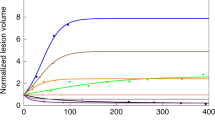Abstract
The results of a series of projects on the cytotoxic drug response of human tumour xenografts are compared. All were performed in one laboratory, using conventional CBA mice that were usually immunosuppressed by thymectomy, cytosine arabinoside treatment, and whole-body irradiation. Results on human tumours arising in 9 anatomical sites are included, with the main emphasis on colo-rectal, pancreas, breast, lung and testis carcinomas, also melanomas. Growth acceleration during successive passage of most of these tumour types was observed. When therapeutic response was measured by a growth-delay method there were wide differences in response to chemotherapy. Testicular teratomas and small-cell lung tumours responded well, breast tumours showed modest response, melanomas, colo-rectal tumours and non-small-cell lung tumours responded poorly. Studies of clonogenic cell survival were made in 11 xenografted tumour lines. They confirmed the range of responsiveness and tendency towards individuality of the growth delay data. Cell survival in most cases was exponentially related to drug dose. This compilation of a large amount of experimental data supports the belief that human tumour xenografts broadly maintain the level of chemotherapeutic responsiveness of the source tumours in man.
Similar content being viewed by others
Rights and permissions
About this article
Cite this article
Steel, G., Courtenay, V. & Peckham, M. The response to chemotherapy of a variety of human tumour xenografts. Br J Cancer 47, 1–13 (1983). https://doi.org/10.1038/bjc.1983.1
Issue Date:
DOI: https://doi.org/10.1038/bjc.1983.1
- Springer Nature Limited
This article is cited by
-
An inhibitor of BRD4, GNE987, inhibits the growth of glioblastoma cells by targeting C-Myc and S100A16
Cancer Chemotherapy and Pharmacology (2022)
-
Xenografts faithfully recapitulate breast cancer-specific gene expression patterns of parent primary breast tumors
Breast Cancer Research and Treatment (2012)
-
Xenograft models of head and neck cancers
Head & Neck Oncology (2009)
-
Establishment and characterization of a new transplantable pancreatic cancer xenograft (PZX-5) in immunosuppressed mice
International journal of pancreatology (1998)
-
Human breast cancer cell line xenografts as models of breast cancer — The immunobiologies of recipient mice and the characteristics of several tumorigenic cell lines
Breast Cancer Research and Treatment (1996)



